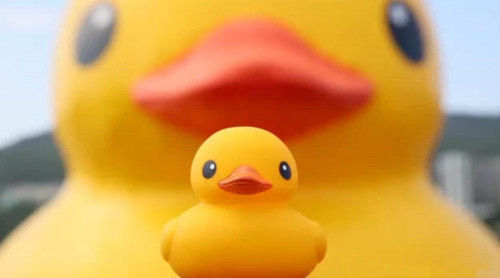|
 |
|
GREETING: The giant rubber duck will be exhibited in Beijing from September 16 to October 17 (FILE) |
The bright yellow giant rubber duck is scheduled to debut in the Chinese capital from September 16 to October 17, the Beijing Design Week committee said on August 13.
The exact location has yet to revealed, although it will likely be outside the city's third ring road.
The 16.5-meter-tall rubber duck kicked off its world tour and has gained plenty of popularity since making its debut 2007. Dutch artist Florentijn Hofman is the man behind the installation.
However, as its scheduled Beijing launch draws near, some Chinese netizens are concerned about its copyright, wondering should the artist be granted the copyright of his enlargement of a bathtub rubber toy?
Copyright debate
On July 12, Xing Xin, a contemporary Chinese installation and performance artist, wrote a blog post expressing his doubts on the copyright of rubber duck's souvenirs.
Titled The Rubber Duck's Copyright Belongs to Whom? the post was viewed over 55,000 times in less than one month. Xing agrees Hofman owns the copyright of the artwork but believes that any derivative products authorized by the artist have possibly infringed the copyright of the original rubber toy. He also questioned whether this phenomenon was riddled in conspiracy.
Xing's view was echoed by some art professionals. Chen Mo, a Chengdu-based art critic, wrote in his microblog that "signs of plagiarism are obviously shown in the shape of the ducks" when he compared the artwork with the toy.
Feng Jiamin, director of Shenzhen Creative Design Intellectual Property Association, believes that creating artwork with existing objects is "allegedly infringing copyright but hard to prove."
Meanwhile, some people are in Hofman's corner. "Though it is not a novel way of artistic expression, Hofman's enlargement of the duck is his expression of ideas. It is the idea that matters in the process of artistic creation," independent curator Bao Dong said.
Hofman was arranging the Rubber Duck's launch in Chengdu, northwest China's Sichuan Province, after its Beijing stop when the topic became all the rage among Chinese netizens.
The artist did not give any direct response, but admitted that the Rubber Duck has not been registered in any country as of yet.
Law experts' view
How could Hofman authorize exhibitions and spinoff duck products when he hasn't registered for the copyright?
Zhao Mingxi and Li Yang, scholars of Shenzhen University Law School, has an idea.
Zhao said the company that produces rubber duck toys might have the copyright of fine art works or industrial design rights. But according Chinese law, copyrights of fine artworks registered by enterprises or organizations are valid for 50 years and the industrial design rights for 10 years.
Therefore, the law no longer protects the rubber duck's copyright because the toy has existed for nearly a century. That means everyone now has the right to make use of the rubber duck which they feel fit without having to obtain authorization. Hofman has the right to exhibit the giant Rubber Duck but has no right to authorize the manufacturing and selling of rubber duck toys.
But Li believes the original rubber duck could hardly enjoy the copyright of a fine artwork given its status as a bathtub toy.
So is it art?
Looking back at art history, objects that were for mere daily use were used to create art. One relevant example is Fountain created by Marcel Duchamp (1887-1968), a French-American artist. Duchamp purchased a urinal in 1917. He reoriented it to a position 90 degrees from its normal position of use, signed his name on it and then exhibited it as a piece of art work.
Claes Oldenburg is another example. Born in 1929, Oldenburg is an American sculptor whose works feature very large replicas of everyday objects such as a shuttlecock, baseball glove and a clothespin.
Sun Zhenhua, vice president of the China Sculpture Institute, said there is no objective definition for a piece of artwork. What counts are the concepts expressed through the piece.
"In the case of Fountain, the relationship between the urinal and people has changed when the former was displayed at a museum," Sun said. "It is an exhibition of new ideas."
(Source: China Culture Daily) | 